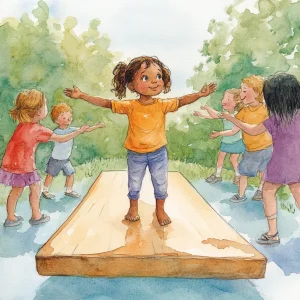Activity
Similar Activities
Balance Beam Adventure: Enhancing Coordination and Focus
Children’s Age: 2–12 years
Activity Duration: 5 minutes
This fun activity called "Balancing Act Fun" is perfect for kids aged 2 to 6. It helps improve coordination, balance, and self-regulation. You'll need a flat surface, a stable boar…
Activity Duration: 5 minutes
Space Odyssey Coding Adventure Game
Children’s Age: 6–18 years
Activity Duration: 0.5 – 1 hours
Let's go on a Space Adventure Coding Game! We'll use a cardboard spaceship, planets, stars, and coding cards with commands. Create a space atmosphere, place the coding cards, and e…
Activity Duration: 0.5 – 1 hours
Enchanted Musical Storytime Adventure
Children’s Age: 2–2.5 years
Activity Duration: 5 – 15 minutes
Join the "Musical Storytime Adventure" for children aged 24 to 30 months, focusing on self-regulation development. Gather favorite storybooks, musical instruments, a cozy rug, and …
Activity Duration: 5 – 15 minutes
Imaginative Tales: Storytelling with a Twist
Children’s Age: 3–6 years
Activity Duration: 5 – 15 minutes
"Storytelling with a Twist" is an engaging activity designed for children aged 3 to 6 to boost self-regulation, cognitive development, and play skills. Create a cozy storytelling c…
Activity Duration: 5 – 15 minutes
Dancing Around the World: Cultural Adventure Dance
Children’s Age: 2–2.5 years
Activity Duration: 5 – 15 minutes
"Dancing Around the World" is an engaging activity designed to enhance children's coordination, balance, and cultural appreciation through dance. By incorporating music, scarves, a…
Activity Duration: 5 – 15 minutes
Nature's Balance Trail: A Tale of Textures and Tales
Children’s Age: 1.5–2 years
Activity Duration: 5 minutes
Nature's Balance Trail is an engaging activity tailored for children aged 18 to 24 months to discover nature, enhance balance, and boost early literacy skills through storytelling.…
Activity Duration: 5 minutes
Ecosystem Adventure Board Game - Nature's Quest
Children’s Age: 7–9 years
Activity Duration: 10 – 25 minutes
An interactive board game where children explore and learn about ecosystems through challenges and tasks.
Activity Duration: 10 – 25 minutes
Nature Scavenger Hunt: Adventure in the Wild
Children’s Age: 4–9 years
Activity Duration: 10 minutes
An outdoor, nature-based activity promoting ecological awareness and cognitive development in children aged 4-9 years.
Activity Duration: 10 minutes
Musical Kindness Quilt
Children’s Age: 8–10 years
Activity Duration: 10 – 20 minutes
The "Musical Kindness Quilt" activity engages 9-year-old children in learning about famous musicians while enhancing communication skills and cognitive development. Children choo…
Activity Duration: 10 – 20 minutes
Whispers of Nature Rhythms: Exploring Beats and Patterns
Children’s Age: 3–7 years
Activity Duration: 10 – 30 minutes
Let's explore "Nature Rhythms" together! We will listen to nature's beats and patterns using rocks, sticks, leaves, and pinecones. Find a safe outdoor spot, gather natural material…
Activity Duration: 10 – 30 minutes
Enchanted Textures: Sensory Treasure Hunt Adventure
Children’s Age: 0 month – 6 years
Activity Duration: 5 – 10 minutes
Let's go on a Sensory Treasure Hunt adventure! We will explore different textures using our sense of touch. Gather textured items, hide them around the room, and guide the child to…
Activity Duration: 5 – 10 minutes
Dance Across Cultures: Around the World Adventure
Children’s Age: 5–12 years
Activity Duration: 30 minutes
Let's go on an exciting "Around the World Dance Adventure" where we will discover diverse cultures through dance and music! Get ready by finding music from various countries and so…
Activity Duration: 30 minutes



























